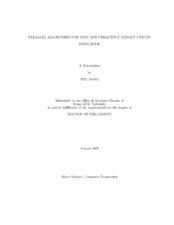| dc.description.abstract | As a most critical form of pre-silicon verification, transistor-level circuit simulation
is an indispensable step before committing to an expensive manufacturing process.
However, considering the nature of circuit simulation, it can be computationally
expensive, especially for ever-larger transistor circuits with more complex device models.
Therefore, it is becoming increasingly desirable to accelerate circuit simulation.
On the other hand, the emergence of multi-core machines offers a promising solution
to circuit simulation besides the known application of distributed-memory clustered
computing platforms, which provides abundant hardware computing resources. This
research addresses the limitations of traditional serial circuit simulations and proposes
new techniques for both time-domain and frequency-domain parallel circuit
simulations.
For time-domain simulation, this dissertation presents a parallel transient simulation
methodology. This new approach, called WavePipe, exploits coarse-grained
application-level parallelism by simultaneously computing circuit solutions at multiple
adjacent time points in a way resembling hardware pipelining. There are two
embodiments in WavePipe: backward and forward pipelining schemes. While the
former creates independent computing tasks that contribute to a larger future time
step, the latter performs predictive computing along the forward direction. Unlike
existing relaxation methods, WavePipe facilitates parallel circuit simulation without jeopardizing convergence and accuracy. As a coarse-grained parallel approach, it requires
low parallel programming effort, furthermore it creates new avenues to have a
full utilization of increasingly parallel hardware by going beyond conventional finer
grained parallel device model evaluation and matrix solutions.
This dissertation also exploits the recently developed explicit telescopic projective
integration method for efficient parallel transient circuit simulation by addressing the
stability limitation of explicit numerical integration. The new method allows the
effective time step controlled by accuracy requirement instead of stability limitation.
Therefore, it not only leads to noticeable efficiency improvement, but also lends itself
to straightforward parallelization due to its explicit nature.
For frequency-domain simulation, this dissertation presents a parallel harmonic
balance approach, applicable to the steady-state and envelope-following analyses of
both driven and autonomous circuits. The new approach is centered on a naturally-parallelizable
preconditioning technique that speeds up the core computation in harmonic
balance based analysis. The proposed method facilitates parallel computing
via the use of domain knowledge and simplifies parallel programming compared with
fine-grained strategies. As a result, favorable runtime speedups are achieved. | en |


